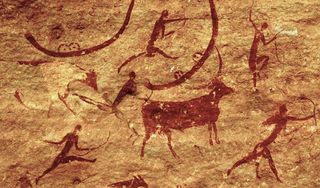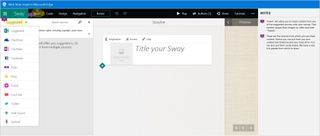Sway and Docs.com are the storytelling tools for the storyteller in each of us
I love Office Sway! If you've followed my work here at Windows Central (and viewed pieces like this one on the web rather than the Windows Central app from which Sways are not visible), you've encountered a liberal use of Sway within some of my publications.

Sways have a wonderful way of enhancing or helping to tell a story. And as we all know, everyone loves a story.

Everyone loves a story
Storytelling is part of the human condition. It is as much a part of us as eating and breathing. It is so natural, so integral to our nature that we do it in almost all of our social interactions likely without our ever taking notice.
We are all storytellers. Moreover, the technology of varying degrees of sophistication has aided us in our storytelling throughout the ages. When technology meets us where we are and seamlessly complements our natural tendencies; that technology can benefit our lives, culture, society, the world and even our future.
When Sway creator Chris Pratley and his team developed the idea for Sway, I believe they devised a tool that connects naturally to the way we as human beings have communicated and consumed our stories throughout the ages.
"The magic that I think Sway brings is really empowering individuals who might not otherwise have the time or the design skills or the technical skills to create really engaging beautiful output, digital documents that live easily in the cloud. It empowers them to really produce these things really quickly and easily." - Nathan Freier, Sway Team Program Manager

Our Story
Before the written word became the primary means by which we recorded and transmitted our thoughts, our ancestors orally told stories to younger generations as a means to preserve our history. In addition to audibly receiving oral tales, as visual creatures, the stony walls of cave dwellings often became the canvases upon which our predecessors recorded pictorial tales.

As human history made its steady march toward the present, our innate propensity for storytelling persisted. Other mediums soon became the canvases upon which our stories were recorded. Bards and poets gracefully wrapped stories in music and rhyme. Artists, sculptors and musicians of various disciplines crafted their stories into powerful visual and audible works. The common man told his stories in the marketplaces.
With the advent of the printing press, stories were soon mass produced and widely distributed. The stage for the professional storyteller, fortunate enough to have his works published, had grown by a magnitude.
Get the Windows Central Newsletter
All the latest news, reviews, and guides for Windows and Xbox diehards.
The digital age has brought the global stage to the common man. No longer are his stories restricted to the marketplaces, his immediate friends, and his loved ones. The internet has made the world accessible to the storyteller in all of us.

If technology is to meet us where we are, storytelling tools for the digital age should match the range of mediums by which we tell and consume our stories. Whether that medium is text, imagery or sound. The tools should also match the simplicity of the natural way we use these mediums to tell our stories.
In the digital age, with a global stage the tools should also provide a means by which our stories can be seamlessly transmitted and formatted across all screens through which they will be consumed.

"But I'm not a storyteller," you say!
But you are! From the time we learn to speak we are storytellers. Consider the child that is just learning to articulate his thoughts. He is quick to tell you about himself. He passionately babbles about what he saw, where he went or what he did. As a matter of fact, that pattern of social interaction, or storytelling, persists with us into our adult lives.
Think about it. When you bump into a friend in public where does the conversation usually flow? I hazard to guess that it more often than not lands on what you saw, where you went or what you did. And that's ok. You see, the person you're speaking to is telling you their story as well.
Storytelling is in everything we do

The businessman presenting a strategic road map. A potential employee interviewing for a job. A chef teaching students how to cook a specialty dish. A woman telling her friends about her Caribbean vacation. A scientist presenting his breakthrough research. A professional storyteller…well you know. They're all telling stories. 'nuff said.
Now from the time of our ancestor's foyer into storytelling to now there have been various methods that we have used to tell our stories. Cave painters used pictures. Bards used poetry and song. Writers used prose. Orators used the spoken word. Every storyteller needs their tools.

Now imagine a canvas that allows the modern man in this digital age, you and I, to use the full range of our storytelling abilities within the context of one medium. A canvas that intelligently combines the most complex of our notions within an easily navigated tapestry of imagery, words and sound. A canvas that is accessible to the most inexperienced storyteller, such as an elementary aged student. Or the professional orator, such as an ordained minister. Or creative wordsmiths like the poets who have walked among us. Or the writer of any age or skill level who has a story to tell or a message to share.
Imagine a canvas that takes the stories that exist in the ephemeral space of our imagination and logs them in that universally accessible place called the "Cloud". A canvas that is dynamic. That even after the story is told, it can be updated anytime and anywhere without destroying the canvas or necessitating the republishing of the work. A canvas that is as alive and dynamic as the life of the artist who is telling the story.
That canvas exists and it's called Microsoft Office Sway.
"We're on a path to see it (Sway) reach the ubiquity of the other Office products… We're essentially doubling our users every month at the moment for the last few months. That's an incredible growth curve… In five years…. we'll have apps on every platform that people expect them on. We'll be used as much as Word or PowerPoint that's what I'm hoping for in about that time frame." – Chris Pratley

Have you been "Swayed"?
I had the opportunity to interview Chris Pratley, the creator of Sway (and OneNote) and General Manager of the Sway Team. Nathan Freier, Program Manager for the Sway team, the man responsible for ensuring the product we see is consistent with the intended design, also sat for an interview. I will share high points and excerpts from each of those interviews in Part 2 of this series. Both of these men are very excited about Sway. And with good reason.
Sway is likely the most robust, dynamic and most user-friendly storytelling tool for the cloud-first, mobile-first world. In an age where we are consuming and creating "stories" of varying complexity on screens of various sizes, a tool that matches the dynamic way in which we interact with our stories must meet us where we are. Sway does this.

Sway is ubiquitous. Anyone with a web-browser can use Sway for free. Simply logging into Sway.com with a Microsoft user account gets you started on your way to creating awesome Sways. There are also apps for Windows 10 and iOS. And per Chris Pratley, a Windows Phone app is currently next in line before Android. (He did concede that things could change.)
Sway is simple. Sway uses an interface called a Storyline where users simply place their text, images and videos in the order they desire. Sway does the rest. Sway uses algorithms that can detect a user's intent. For instance, it can detect the color in the images you use and chooses the general color design of the Sway to match what you have chosen. Because it is designed to detect intent many of the "knit-picky" controls found in other tools are either absent or hidden. Sway is meant for the times when you just want to create something beautiful, engaging and dynamic, but you want to do it quickly and easily. Chris Pratley believes that this is the case most of the time.

Sway is robust. Sway is meant to enable users to create Sways that are just as engaging as professionally built websites. With the ability to add content from sources like YouTube, Bing, Facebook, Flikr, PicHit, Twitter, OneNote, OneDrive or to upload content and Office documents from your own device, Sway has a rich repository from which to draw.

Sways are easily shared. Sways live on the web. Unlike other types of documents that need to be attached to an email to be shared, because Sways live on the Web, they have a web address. If you want to share your Sway simply use the built in share options.

Finally, Sways look great on every screen. Period. Sways do not exist in a fixed format. A Sway will reflow to match any screen through which it is being viewed.
So what about organizing, managing and promoting your Sways? Yeah, Microsoft's got you covered.
What's up Docs.com?
Under Satya Nadella's leadership, Microsoft has taken a bold and definitive approach toward positioning the firm as a platform company. From a proliferation of cross-platform productivity apps to an aggressive and ever-growing cloud strategy. To the universal Windows 10 operating system, it is clear that Microsoft wants to be the power that drives productivity where users are.
It is within this context that Docs.com completes the path begun by Sway. Sway, as we learned above, is a tool designed to quickly and easily create rich web-based documents. However, just as in the pre-digital world, any created work without a publisher as a means of distribution has very limited exposure.
Docs.com is the publishing platform designed specifically with Sway in mind. Users can use Docs.com to arrange their Sways in various categories for easy browsing. Microsoft will do all of the heavy lifting such as SEO (search engine optimization) and analytics. Chris Pratley shared that richer analytics will be coming to Docs.com so that "authors" can better monitor how others are interacting with their content.

It's the remix
Because Sway is the native editor for Docs.com, users can also upload their other Office documents such as Word, PowerPoint and Excel to Docs.com. It will be interesting to watch the evolution of this powerful platform. As it is now in its infancy, many may not yet see the potential of a platform designed to allow anyone with a browser (and coming apps) to create rich, dynamic, interactive web-based content.
Yet with Sway being a part of the most prolific productivity suite on the planet (with over 1 billion users) and a projection to reach the ubiquity of its sister tools, Sway as Nathan Freier puts it, can literally remix the web. Their native cloud-based status coupled with easily utilized built-in sharing tools makes the potential viral proliferation of Sways an intrinsic quality of the technology. Their ability to be easily embedded within and shared from standard web pages enables Sways to easily coexist alongside and within the current web paradigm.
As Sway's begin their inevitable and natural march into mainstream use, with Docs.com functioning as a searchable hub from which to manage, catalogue and organize Sways, Microsoft's document creation and publishing platform may very well revolutionize much of what we do on the web. This can change how businesses advertise. How employers seek prospective hires. How job seekers seek employment. How academics create and share work. How writers create and publish. How students complete and submit assignments. And even how scientists conduct research. The possibilities are endless.
So I ask again. Have you been "Swayed?"
Sound off in comments!
Jason L Ward is a columnist at Windows Central. He provides unique big picture analysis of the complex world of Microsoft. Jason takes the small clues and gives you an insightful big picture perspective through storytelling that you won't find *anywhere* else. Seriously, this dude thinks outside the box. Follow him on Twitter at @JLTechWord. He's doing the "write" thing!

